June 14, 2025 | 10:46 GMT +7
June 14, 2025 | 10:46 GMT +7
Hotline: 0913.378.918
June 14, 2025 | 10:46 GMT +7
Hotline: 0913.378.918
The cold pig farm following the model of a cold, enclosed circulating farm belonging to Mr. Huynh Quoc Cuong in Long Chu commune, Ben Cau district, Tay Ninh province is considered a typical model in this province in restructuring the livestock sector.
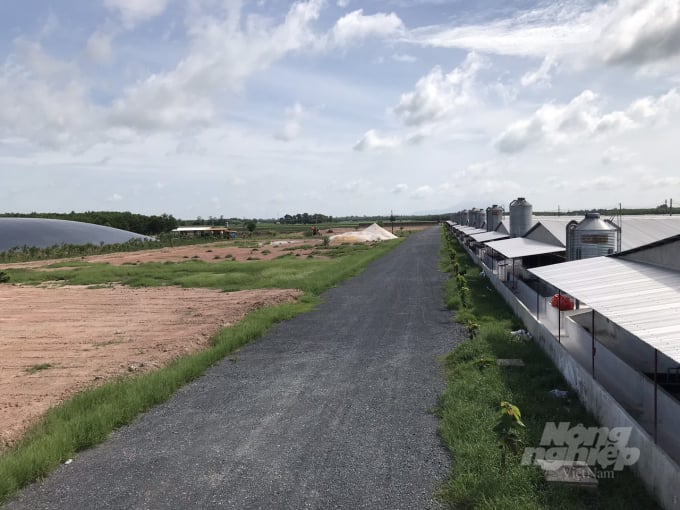
A view of the pig farm following the model of a cold, enclosed circulating farm by Mr. Huynh Quoc Cuong in Long Chu commune, Ben Cau district, Tay Ninh province. Photo: Tran Trung.
Here, we were able to observe the area of nearly 20 hectares, of which, about 2 hectares were spent by Mr. Cuong to build 14 rows of cages designed according to standards, with an improved industrial exhaust fan system to help keep warm in the winter and cool in the summer. The rearing area is arranged scientifically, breeding sows, piglets, commercial pigs are arranged separately for convenient monitoring and care. Outside the camps are large biogas digesters for waste treatment. Notably, in order to ensure disease safety, the entire area outside the breeding area is about 18 hectares, in which he grows trees for timber to create a buffer zone and sets out the rules of "no-ins, no-outs" to limit diseases.
According to Mr. Cuong, his family has a tradition of raising pigs, in order to acquire the property as it is today, he has experienced many failures. Specifically, at the end of 2016, the market witnessed a decline in the price of live pork across the country, followed by foot-and-mouth disease and African swine fever, which seriously affected the development of pig production in the province and particularly in his family.

The farm is treated thoroughly for diseases before putting pigs into production. Photo: Tran Trung.
In the context that many households are giving up their herds and chose not to re-herd due to losses, with the determination not to back down from difficulties, he studied and researched on his own in books, newspapers and spent time visiting cold farm model of large-scale livestock companies. Realizing that raising pigs in the form of a enclosed industrial cold farm requires a large investment but as a result, it yields healthy pigs with less disease, rapid weight gain, high meat ratio, good prices favored by traders. In 2017, Mr. Cuong discussed with his family the decision to invest in developing pig farming in the direction of concentration.
“Moving to a big business is worrying but I am confident with this low-risk, high-effective livestock direction. And reality has proven that, by now, the farm is stably maintaining 600 sows and 4,000 pork pigs. Every month, the farm produces 1,200 breeding pigs and 1,150 pork pigs, bringing in a profit of nearly 1 billion VND/month", Mr. Cuong revealed.

Automatic feeding system helps to reduce labor costs, save on feed and increase profits. Photo: Tran Trung.
Sharing more on his secret of success, Mr. Cuong added, besides the production process according to VietGAHP standards; the farm also invested in applying synchronously new scientific, technical advances in pig production such as automatic bran pumping silo system, waste treatment technology (feces, wastewater ...) to produce biogas to overcome environmental pollution, limit epidemics, contributing to increasing profits.
“Thanks to investment in feed silos and feed conveyor belts, it saves labor (about 2 workers/farm) and food bags (10,000 VND/bag). Thereby, the farm reduces production costs, the feed in the system flows to the feeder according to the pig's needs, without causing a surplus of feed.
In addition, the waste treatment technology (feces, wastewater…) also produces biogas for generators. With this amount of power, it is enough to serve 50% of the camp's daily and production needs. Thus, with a litter of pigs, the farm saves an additional 200 million dong, while minimizing environmental pollution", said Mr. Cuong.
Promoting the results achieved, Mr. Cuong is continuing to build similar farms. It is expected that by the end of this year, his farm of nearly 5,000 commercial pigs will continue to be put into operation.

The well-developed pig herd is the motivation for Mr. Cuong to continue expanding the farm size. Photo: Tran Trung.
Mr. Huynh Thanh Hung - Head of Ben Cau District Department of Agriculture and Rural Development said that as the locality still has a lot of room to develop in the livestock sector, Mr. Cuong's enclosed circulating farm is the first model in the locality, not only making great contributions to the agricultural sector but also opening up new directions, encouraging farmers here to boldly follow.
“From Mr. Cuong's model, Ben Cau district has formed a number of enclosed cold pig farms, thereby dealing with waste and environmental pollution problems, contributing to increasing the proportion of the agricultural sector and solving the problem of rural labor", Mr. Hung emphasized.
According to Tay Ninh province Department of Agriculture and Rural Development, the restructuring of the livestock sector has been implemented in the province for many years and was initially effective. Enclosed, disease-free and non-antibiotic farming models need to be replicated. The province always encourages households to raise in the form of effective farms.
Currently, there are 106 farms and 250 livestock farms in the area with the percentage of pigs raised on them reaching 83.8% of the total pig herd. In which, 59 farms (accounting for 47% of the total pig herd) are reared concentratedly in the form of cold, enclosed farms and signed offtake contracts with businesses, 15 livestock farms raise pigs according to VietGAHP standards or disease safety. These are the results achieved in the agricultural sector's efforts to restructure livestock.
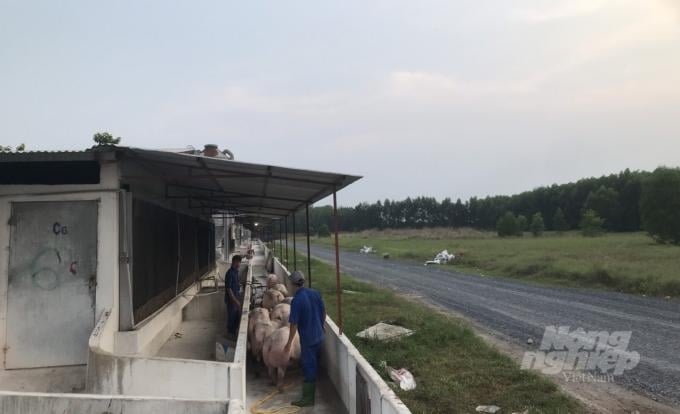
Mr. Cuong's enclosed circulating farm opens up a new direction, stimulating local people to boldly follow. Photo: Tran Trung.
Mr. Nguyen Dinh Xuan, Director of Tay Ninh Department of Agriculture and Rural Development, added that the livestock sector in the province currently accounts for only 17% of the agricultural structure, but contributes greatly to GDP for the whole sector, especially the enclosed cold pig farms, applying scientific, technical advances to production. According to calculations, the current value of 1 hectare of cultivation only brings about 102 million/year on average, while the value of 1 hectare of livestock farms brings in at least 15 to 20 billion VND.
“It can be seen that with the help of science and technology applied in all stages of the production process, it has created new values for livestock, ensuring standards and quality. In addition to the initiative of the farms, the locality has developed a plan to form a high-tech agricultural area applying high-tech pig production by 2025 with a total herd of over 40,000 heads/herd" Mr. Nguyen Dinh Xuan confirmed.
Translated by Nguyen Hai Long
/2025/06/12/3721-2-202745_83.jpg)
(VAN) TH made an impression at Seoul Food 2025 with its line of natural beverages, paving the way for Vietnamese food products to enter the South Korean market.
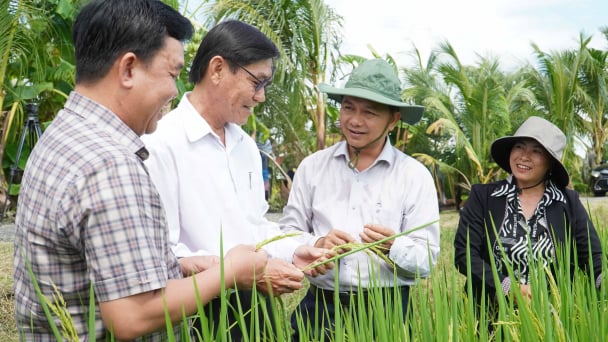
(VAN) Soc Trang's success in rice exports stems from a strategy of developing fragrant and specialty rice cultivation areas and standardizing production toward low-emission practices.
/2025/06/11/1311-5-120811_839.jpg)
(VAN) The pig farming industry is facing the challenge of comprehensive restructuring to meet requirements for quality, safety, traceability, and market expansion both domestically and for export.
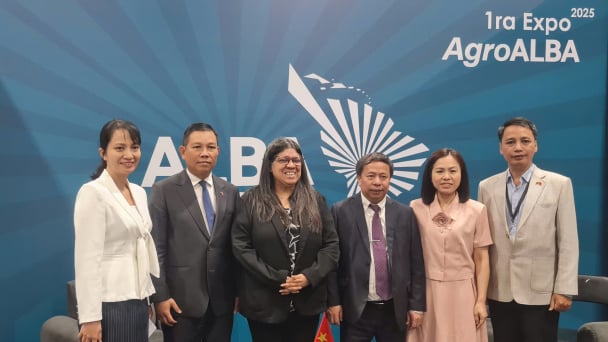
(VAN) Vietnam considers participating in ALGROALBA in order to expand agricultural production, coordinate the assessment and effective exploitation potential land.
/2025/06/05/5314-1-184727_407.jpg)
(VAN) From seemingly worthless fish scales and skin, enzymes and lactic ferments can transform by-products into peptides, opening a sustainable, effective business direction and elevating Vietnamese seafood.
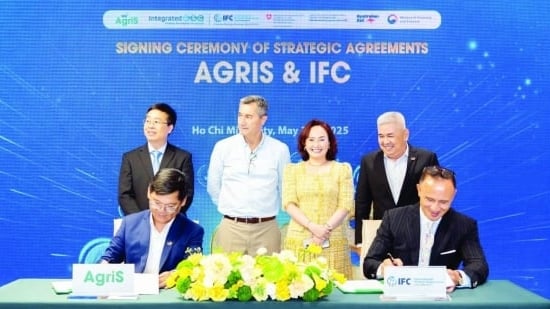
(VAN) TTC AgriS and IFC signed a strategic partnership to develop a sustainable agricultural value chain, aiming to achieve the Net Zero target by 2035.

(VAN) Seafood by-products are opening a new path, combining green growth and technological innovation to enhance the industry's value.